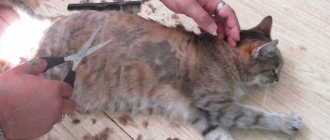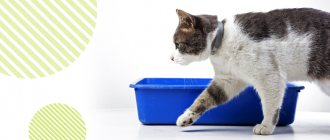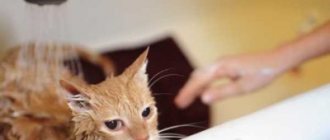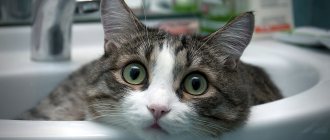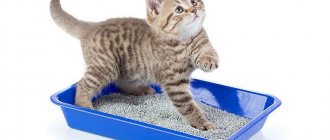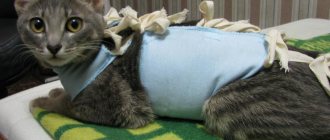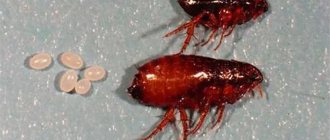Compliance with the rules of pet hygiene is the key to its health. Despite the fact that cats are one of the cleanest animals, it is necessary to carry out water procedures periodically.
It is most important to wash your cat if it has access to the outdoors. During a walk, the fur collects dust, in addition, the pet can become infected with something through spoiled food, dirt and contact with other animals.
How often can you wash your cat?
Cats do not need to be washed daily or weekly; bathing once every 2 months is considered normal.
Watching the cat, it is easy to notice that in her free time from playing and feeding, she likes to “preen” - licking her fur, paws and tail. The animal keeps its fur clean on its own, so it does not need regular bathing. Moreover, too frequent washing can harm the cat, as the pet's subcutaneous glands produce a protective lubricant. The substance is distributed throughout the coat, makes the hair silky, and also serves as a barrier against bacteria. Interesting fact: cats and cats groom themselves differently. Cats spend more time licking their fur and do it more thoroughly than males.
It is important to distinguish between thoroughly washing the cat with shampoo and wiping individual areas of the coat as it gets dirty. If the cat got dirty in the toilet or came home from the street, wipe off the dirt with a soft cloth previously moistened in warm water. This will not harm the pet.
You need to teach a kitten to wash from the age of 4-5 months, so that bathing becomes a habitual ritual, and, as an adult, he would not experience fear of water. In any case, you will have to wash your domestic cat throughout its life, because its fur gets dirty and matted, and you really want the “fur coat” to always be luxurious and well-groomed!
Permissible procedure frequency
For almost every cat, bathing is stressful; they do not like water. The thing is that cat fur creates an air cushion over the skin, which provides the kitty with a feeling of comfort and warmth. Therefore, by wetting a cat's fur, you deprive it of its usual comfort.
A healthy cat should be washed no more than once every two months. Excessive bathing with shampoo can only cause harm: dry out the skin and cause irritation. Representatives of long-haired breeds need to be washed a little more often, as their coat requires more careful care.
When should you bathe a cat?
It is necessary to bathe a cat only if there are good reasons for doing so. Indications for washing your pet:
- More than 2-3 months have passed since the last bath, and the cat’s fur has become dull, darkened, and matted;
- the cat is very dirty, for example, rolled in the mud or covered in paint;
- If parasites are found in the fur, you need to immediately bathe the cat and then treat the “fur coat” with an antiparasitic agent. You should especially carefully examine cats that are often outdoors and can “catch” ticks and fleas;
- washing may be recommended by a veterinarian if a cat develops allergies, lichen, dermatitis and other skin-related diseases;
- if you find a kitten on the street and decide to take it into the house, then you cannot do without water procedures;
- In preparation for the exhibition, you will have to wash the cat with a special shampoo and give your pet a “styling.”
Cleansing with dry shampoo
This is the simplest, most gentle way. What are its advantages over the traditional one? Using dry shampoo will not make your cat nervous, and your hands will remain intact.
You can use this product once every six months. In this case, the procedure will not become more complicated than regular combing. But you should know that if it is carried out on a carpet, then it will be quite difficult to clean it from the powder. After rubbing the shampoo a little into the animal's fur, comb it thoroughly.
Contraindications for swimming
In some cases, you cannot wash your cat:
- during rehabilitation after surgery. Typically, complete recovery takes about a month, but it all depends on the degree of intervention in the body and the pet’s health condition;
- late pregnancy. Washing can be very stressful for a cat and can even cause premature birth;
- within 2 weeks after vaccination. The cat’s immunity is weakened, and it is better to postpone washing;
- if the animal is sick, bathing can worsen its condition. Cancel water procedures and follow the veterinarian’s recommendations.
Health status
Sometimes bathing is necessary according to the indications of a veterinarian, but in some cases, on the contrary, washing the cat is prohibited. Such features are individual in nature, but there are a number of general rules.
A cat is being vaccinated
Vaccinations
Immediately before vaccination, you should not wet your pet, as injections are given on dry skin. However, you need to make sure that the pet brought to the doctor’s appointment is clean.
After the injection, it is not recommended to wet the cat for 5–7 days, sometimes up to 14 days. The details are always given by the veterinarian conducting the appointment.
During estrus, after mating
The answer is somewhat unexpected - yes, it is possible and even necessary. Moreover, I’ll tell you, some cats can only be bathed during estrus without problems or nerves. You can immediately take advantage of the situation and untangle the resulting tangles in a long-haired cat.
But after mating has occurred, it is not recommended to wash the cat. It would be better to wait about a week. Then the cat will definitely come to its senses, to its normal state, and then it will be possible to bathe it calmly, without hysterics.
If pregnant, postpartum or breastfeeding
The period when a cat bears kittens is very important and responsible in the life of both the pet and the owner, especially the last stage of pregnancy. The body undergoes a lot of dramatic changes, so you should not overload your cat with additional stress in the form of bathing. In the first weeks of pregnancy, you can wash as usual, but starting from the 20th to 40th day, bathing is canceled. If necessary, if your pregnant pet gets dirty, it is better to wipe it thoroughly with a damp cloth, then wipe it dry.
A cat that has recently given birth does not need to be bathed, but it is important to keep her clean. To do this, the cat is dried with damp towels and then dried.
Nursing cats should also not be bathed unnecessarily, as stress has a detrimental effect on milk production and the condition of the body as a whole, plus an additional risk of freezing. The well-being of the mother directly affects the health of the offspring.
After sterilization
Bathing after surgery depends on the timing of removal of postoperative sutures. It is from this moment that we start. Water procedures are allowed no earlier than a week after the removal of sutures and normal healing of the postoperative wound.
Diseases, surgeries
For a number of diseases in cats, bathing is contraindicated, especially for animals that have undergone surgical operations. During the period of treatment and recovery, weakened pets are prohibited from stress factors, one of which, to some extent, is bathing. Getting wet also complicates wound healing and carries an additional risk of secondary infections and colds.
However, with some diseases, animals become very dirty with various secretions, so sometimes you have to bathe sick pets. Dried crusts, feces, pus and similar substances are an excellent environment for the development of pathogenic microflora (pathogens), so you need to regularly remove dirt and keep your pet clean.
Advice! Caring for a sick pet is a strictly individual matter, but there are general rules. In any case, you need to consult with your veterinarian; he will tell you and show you how to monitor your cat during treatment.
Kittens bathe in the sink
Age indications
The fur of kittens, especially in the first weeks and months of life, differs from the hair of adult animals, even if they are representatives of the same breed. In some cases, bathing kittens is even easier than adult cats - it’s easier to fix and hold, it’s faster and easier to lather and wash off the foam.
However, you need to carefully choose the right shampoo that matches your age and situation. Insectoacaricidal shampoos are not suitable for many kittens due to age restrictions, so it is useful to carefully read the instructions and also consult with specialists.
You also need to be careful when bathing aging pets. Older cats' fur becomes increasingly brittle and weak as they age. It is necessary to monitor the condition of the hair of an elderly pet; do not bathe it unnecessarily, so as not to expose it to unnecessary stress and the danger of freezing. It is better to give preference to combing and polishing the wool with a soft cloth. Using dry shampoos also works well.
Preparing to wash your cat
Trim your cat's nails to prevent him from scratching you while bathing.
Comb the fur and remove tangles.
Choose a place for bathing - a bathtub, sink or basin. The bathtub is perfect for large cats; you just need to cover the bottom with non-slip bedding. Many owners wash their pets in sinks. The option with a basin is less convenient, since the cat may begin to grab onto its edges; give preference to a container with a volume of about 30 liters or buy a special bath.
Remove all foreign objects from the sides of the bathtub or sink, hide washcloths and other things that the cat can get caught on.
Make sure you have everything you need to bathe your pet on hand:
- shampoo selected specifically for cats (laundry soap and detergents are not suitable for humans - cats have a different skin Ph);
- a hat that covers the cat's ears, or cotton swabs that can be placed in the ears, or you can tie a small bag on your head like a scarf;
- soft washcloth for washing hair;
- a large towel in which to wrap the cat after washing so that it does not freeze and cannot scratch you;
- standard towel for collecting remaining moisture and drying;
- caring assistant (preferably).
Check the temperature in the room where you are going to wash your cat. Pets can easily become hypothermic and get sick, so the air should be no colder than +22 °C.
Pour water into the bathtub, basin or sink in advance. The cat is more afraid not of the bath itself, but of the sound of water pouring from the tap. Before starting water procedures, add warm water to a level of about 10 cm so that the water reaches the cat’s belly. The animal must stand confidently on its paws, but so that its head does not get wet. By the way, you can also pre-fill a watering can with water, with which you can then wash off the foam from your pet if he is afraid of the shower. The water temperature should be 38-40 °C. If you don't have a thermometer, place your hand in water up to your elbow. If you do not feel the water, then it is suitable for a cat.
How to properly wash a cat
Before the water gets cold and the cat suspects something is wrong, grab her and take her to the bathroom. Talk to your purr gently, do not make sudden movements that could frighten your pet. Don't forget to close the door - if the cat escapes, it will be difficult to catch, and wet paw marks will remain all over the apartment (possibly along with foam, if you manage to soap the cat).
Gently place the cat in the bathtub, basin or sink. During the dive, you can hold it by the scruff of the neck to prevent the pet from breaking free and scratching you. Put a bathing cap on him or put cotton swabs in his ears. Run warm water over the fur, avoiding the eyes, nose and ears.
It is likely that the cat will be unhappy and begin to resist. She will have to be persistent - for her own good. Grasp the cat's shoulders directly under your chest in your left hand if you are right-handed. This way, your dominant hand will remain free and can be used to lather the animal. If the cat is waving its hind legs, then you just need to sit it down and hold it so that it cannot jump and kick.
At this stage, the assistant will make your task much easier - he can water the cat from a watering can or shower, supply shampoo, a towel and other necessary items, and you will do all the manipulations with your free hand.
Note: pet stores suggest using a short leash with suction cups to bathe your cat. This accessory makes sense to use only as a last resort, since the pet may be more afraid of the leash than the washing, and in the future it will be difficult to lure the cat into water treatments.
Now apply shampoo to the wet cat's fur with light massaging movements. Consistently soap your back, chest, belly and tail, don’t forget about your paws and chin. Do not use too much shampoo so that you do not have to wash off the foam for a long time.
Using a special washcloth, gently wash the cat's face. If you want to wash your cat's hair, ask an assistant to pinch his ears or put cotton swabs in them. Also make sure that water does not get into your cat's nose.
It's time to thoroughly rinse your cat's fur. Rinse off the foam strictly from top to bottom. It is convenient to wash off the shampoo with a hand shower, just do not lift it very high. Residues of detergent should not remain on the cat's skin, as this may subsequently lead to irritation.
If you rinse your pet's fur using a basin, consider its length. For a short-haired cat, one basin will be enough, while for a long-haired cat, several.
Important: you should not wash your cat after feeding or immerse it in water with its head.
When the shampoo is rinsed, remove the purr from the water, wrap it in a large towel and hug your “cocoon” for a few minutes. The cat should come to its senses and calm down.
Adaptations
To make bathing a cat easier, some pet product manufacturers offer assistive devices. The meaning of such devices is similar, but the designs are slightly different.
Cat washing net
Bag
This is a small round bag with a drawstring top, made of thick waterproof fabric. Place the cat inside and fill it with water and dissolved detergent. Only the pet's head is left outside, tying the strings of the bag under the chin.
Thus, the cat is immersed in water, but cannot escape or harm the owner. It is convenient to use for bathing struggling cats, especially if you need to soak them for some time in an antiparasitic, dermatological or other solution.
Net
It is sewn like a bag, but has small slits, which is why the order of use is different. Also in this mesh bag there are holes for the paws and tail, which can be zipped if necessary. The cat is placed inside and then bathed as usual. Such a device significantly limits the pet’s movements, which helps protect the owner from injuries that can be caused by a violent animal under stress. The mesh also reduces the cat's attempts to escape to almost nothing.
Cat bathing cage
Cell
In practice, bags are less common, but sometimes you can come across such a device. It is a metal structure with a flat bottom and a semicircular top, flattened on the sides.
Designed to restrict the cat's movements. There is enough distance between the bars to stick your fingers through and wash the cat, but at the same time the cat cannot get out of the closed cage or turn around in it. In such a device you can not only bathe, but also dry your pet with a hairdryer.
You should remember the safety rules for using such devices. Before use, you must check the integrity of the device and its reliability. You cannot leave a cat in a constrained state for a long time, this can have a bad effect on its physical and psychological condition. Bathing bags and cages should not be used unnecessarily. As in any other case, you must praise and encourage the cat; you cannot scold, raise your voice, or scare. After bathing, you need to treat him with a treat.
Drying wool after bathing
Take the freshly washed cat into the room and dry it with a towel. For short-haired cats, one towel will be enough, and for long-haired cats, do not skimp on 2-3 pieces. You can place your pet on a newspaper or hoe so that the dripping moisture is absorbed faster.
For your information: a cat has a so-called air cushion between its skin and the top layer of fur. This layer of air is heated by the animal's body heat and protects the cat from freezing. During bathing, the fur gets wet and temporarily loses its thermoregulatory properties, which is why it is so important to warm the cat with towels after washing and protect it from drafts.
If the cat is not afraid of a hair dryer, then about 10 minutes after bathing you can lightly dry his fur. The air flow should be warm, but not hot. If the cat is afraid of electrical appliances, it is better to wait until the “coat” dries naturally.
Use a special comb to comb the fur.
After washing, your domestic cat needs to stay warm for at least an hour.
Emergency methods
In extreme cases, when an animal shows aggression and flatly refuses hygiene procedures, and the owner definitely needs to give it a bath, you can resort to emergency methods. For these purposes, you will have to purchase a special suction cup mount at the pet store.
The suction cup itself is attached to the wall of the bathtub, and the loop attached to it is placed around the cat’s neck. You should not worry about the safety of your pet. The product is made in such a way that, while fixing the cat, it does not choke it, providing the opportunity, in a pinch, to wriggle out of the loop.
Then you can calmly move on to the bathing process. For long-haired cats, in addition to shampoo, it is recommended to use a special degreasing paste. This product is applied to dry wool, left for 5-6 minutes, after which it is carefully washed off with warm water.
At the end of the procedure, you can use a balm for cats to avoid drying out the skin, making your pet’s coat especially beautiful and giving it a healthy shine. In addition, balms help prevent the appearance of dandruff.
How to wash a cat that is afraid of water
What to do if your cat is afraid of water? Do you really have to give up bathing completely? This problem can be solved - be patient and smart.
Firstly, do not neglect trimming their nails before washing, because during bathing, especially impressionable cats become very belligerent.
Then play with your cat thoroughly to get him relaxed and tired. You cannot feed your pet.
Having lulled the mustache-striped vigilance, start washing. You need to lower your cat into the water gradually, distracting him with toys. Water should be poured in advance so that the cat does not wait extra time and is not afraid of the unusual sound.
No matter how the cat behaves while washing, there is no need to yell at it or physically punish it - this will only bring additional stress to the animal. To limit movement, you can use a special bathing net, where the cat is placed, like in a bag, and does not go anywhere. Maybe it will remind him of his favorite box?
After finishing washing, treat your cat with a treat - this way she will know that there is a reward waiting for her for bathing!
If your pet still cannot overcome its panic fear of water, you can wash it with dry shampoo. This is a great alternative to traditional shampooing because a good dry shampoo cleans almost as well as a liquid shampoo. Apply the powder to the cat's fur, wait a minute and brush the powder and dirt out.
And a few more tips
- Under no circumstances should you yell at your pet while bathing; remember that he is under extreme stress; calm him down in a quiet voice.
- Rinse the fur very thoroughly after shampoo - low-quality products can be toxic to the animal.
- If the cat gets dirty with something oily, lubricate the spot with butter before bathing, massage it a little and blot it with a paper napkin or towel.
- When removing fleas using a special shampoo, first wet its neck so that they do not run onto the animal's head.
How to wash your cat's eyes and ears
So, even the most capricious cat was washed, but during bathing we went around the eyes and ears, and they should also be clean.
The cat's eyes are wiped with a cotton swab dipped in clean boiled water or a weak solution of tea or chamomile. Movements should be light, no need to press or rub your eyes.
It's time for ears. There is no need to clean them unless they become dirty. However, after washing the cat, water could get into the ears. You need to wipe the outer part of the ear with a cotton swab, on which it is better to twist an additional layer of cotton wool. Use a clean stick or dip it in a drop of Vaseline oil. Water and other liquids cannot be used. As a rule, cats love to clean their ears and are happy to present them to their owner. Healthy cat ears should be pink, clean, and free of unpleasant odor.
Features of washing cats of different breeds
Some purebred cats have coat characteristics that affect their care. In general, we can say that long-haired cats need to be washed more often than short-haired cats.
A common myth concerns Sphynx cats - supposedly because of their oily skin they need to be washed once a week. In fact, it is better to wipe the Sphynx with wet wipes or a soft cloth, and bathe it only if it is very dirty.
The Burmese cat has a very impressive, shiny, short coat, the beauty of which must be maintained. Instead of washing fine fur, which can make your cat look like a hedgehog, wipe it daily with a piece of suede or a damp cloth. This will help give the “fur coat” a glossy shine. Once a week, the cat should be combed with a mitten or brush. You can use a special cat antistatic agent. Your chocolate will definitely love this massage!
British cats and Maine Coons have sensitive skin, so it is extremely important for them to select specialized shampoos based on their coat type. From low-quality cosmetics, cats can begin to constantly itch and develop dandruff.
Bathing a cat before a show
Before participating in the exhibition, any domestic cat will have to be washed. Such bathing will have some features:
- You need to wash the cat twice before the exhibition; during the second wash, use a tinted shampoo (or balm) selected depending on the color;
- the foam is also washed off 2 times, first with water, then with a rinse aid or a weak solution of vinegar;
- while drying with a hairdryer, the wool is smoothed with a massage comb with antistatic teeth, starting from the back and ending with the collar;
- Now you can apply powder to the still slightly damp “fur coat”, which will absorb the remaining moisture and make the coat smooth;
- After a couple of hours, finish treating your cat's fur by applying a protein conditioner.
Life hack: how to choose a tinted shampoo for cats of different colors
White pets are washed 2 or even 3 times with shampoo intended for white cats. When reapplying, leave the shampoo on for 2 minutes for a deeper effect, and then be sure to rinse well. White shampoo is also suitable for chinchilla and silver marbled cats, but there is no need to leave the detergent on the coat. If a cream, blue or lilac cat seems a bit dark to you, use the same shampoo to create a lighter, brighter shade.
Cats with rare red, tortoiseshell and merle colors should be washed with red or bronze shampoo. If your cat has a chocolate-colored coat, add a few drops of black to the bronze shampoo. Black shampoo is suitable for fluffy beauties of black colors.
Follow the instructions, and your cat will outshine all its relatives at the show!
What to do when you panic
To prevent the animal from panicking, talk to your pet in a calm voice. If she starts hissing, breathing heavily, crying, or meowing pitifully, try to calm her down. If all else fails, she gets very scared. Stop and limit yourself to wiping with a damp washcloth.
If the cat is very dirty, you can use the dry bathing method:
- Buy dry shampoo. If you don't have it, cornstarch will do.
- Sprinkle the powder onto the cat's fur.
- Rub into the fur using gentle movements.
- Leave for 20 minutes.
- Remove starch with a brush.
This method does not traumatize the cat’s psyche as much, but it will not work if you need to wash off a toxic substance that has gotten on your pet’s fur. In this case, a full bath is necessary.
